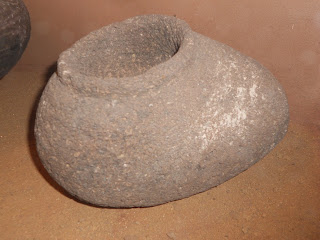 |
| Scenery at Ghost Ranch, NM |
The New Mexico pueblo has been and remains a large part of southwest American culture. Over the centuries, many interesting artifacts have been uncovered all over the southwest and fortunately there are several unique museums that make great additions to your New Mexico vacation planner.
One very interesting southwest pueblo culture and the one highlighted in this article, dates back to between 1000 and 1300 AD. These were the Gallina people. The Gallina culture dates well before the Spanish occupation of the southwest and was located in the north central region of New Mexico.
Florence Hawley Ellis Museum of Anthropology
This is a museum that you want to add to your New Mexico vacation planner for several reasons. The Florence Hawley Ellis Museum of Anthropology is located at Ghost Ranch in northern New Mexico. Florence Hawley Ellis was one of the first women to receive a PhD in anthropology. Ellis received her PhD from the University of Chicago in 1934 and made beautiful Ghost Ranch her home. Dr. Ellis was also a long time professor of anthropology at the University of New Mexico in Albuquerque. Dr. Ellis was involved with and led Ghost Ranch archaeology excavations from 1971 until 1990. Many people may also remember that Ghost Ranch was home to the artist Georgia O'Keeffe.
The Florence Hawley Ellis Museum of Anthropology features exhibits covering a very wide range of Native American artifacts. Some of these are highlighted below.
 |
| Bandelier Black on White |
Information about the Gallina is scarce. One of the most sought after answers pertaining to the Gallina culture was why did it simply disappear? Most studies of this subject point to the the year 1275 AD as the time the culture vanished. The Gallina settlers either left the region or were exterminated. It's a fact that almost all Gallina ever discovered appeared to have been killed.
One possible scenario from historians claim that they may have been murdered by the Anasazi. What is known is that whatever happened to these people, if conflict with the Anasazi did occur, the victors moved on and didn't seem to occupy the Gallina land.
The Gallina Artifacts
On the standpoint of Gallina artifacts, there are several interesting exhibits on display. The Gallina culture left us evidence of their architecture, pottery, tools, shells and stone pipes. The Gallina architecture, for example, consisted of both surface structures and pit houses. A typical village might have from five to twenty homes. The villages were also known to have a north to south orientation.
 |
| Shoe Pot |
The large Bandelier Black on White shown in the photo above is a storage jar. The Rio Grande region potters created distinctive local varieties of this pottery. This pottery employed black mineral paint which was believed to be prior to 1200 AD. After 1200 AD black vegetal paint was mostly used. The paint was used against a white, off-white, or a light gray background. The Black on White Pottery appeared to die out after 1750 AD. The Bandelier name attached to this pottery is indicative of the area where it came from. Today's Bandelier National Monument is very nearby the Rio Grande where most of the pueblo people had settled.
Shoe Pot
The shoe pot shown above was a cooking vessel. The shoe pot is a asymmetrical vessel with the opening at one end, and typically a handle at the rim of the opening. These pots were used all over Mexico and into present day New Mexico.
Gallina Water Container
Another interesting pueblo pottery artifact is the Gallina Water Container. The container shown in the photo was used for exactly what it's name implies. Gallina Pottery was of two kinds. Utility wares and decorative wares. It's interesting to note that vessels such as this have been and are used to study the movements of the pueblo people. In this case, the movement of the Gallina. Most contend that the utility vessels and the decorative vessels really originate form different times. The ceramic conservatism evident in Gallina ceramics as opposed to other pueblo peoples is one reason why the Gallina have been thought to have been both geographically and culturally separate from other New Mexican and southwest pueblos.
Two additional Western Trips photo articles you'll find interesting area a Visit to the Puye Cliff Dwellings just a short drive northwest of Santa Fe New Mexico the very unique Mesa Verde National Park in southwestern Colorado.
Visiting the Florence Hawley Ellis Museum of Anthropology
This very unique museum is located on the grounds of Ghost Ranch. Ghost Ranch is located about 47 miles north of Santa Fe New Mexico. The drive from Santa Fe is about one hour.In addition to exhibits from local artists, the Florence Hawley Ellis Museum of Anthropology displays ancient artifacts from Paleo Indian culture of 10,000 years ago through ancestral Puebloan periods to present time pottery and weavings.
Today, Ghost Ranch is a conference center set in one of the most beautiful parts of New Mexico. Ghost Ranch serves also as both a retreat and an educational center. Many courses are offered during the year. Some can be commuted to and others offer accommodations and meals at the ranch.
If you haven't already, you may just want to add a visit to New Mexico and it's many pueblo sites and archeological museums to your upcoming vacation planner.
The map below will show you the exact location of the museum and Ghost Ranch.
(Article and photos copyright Western Trips)



